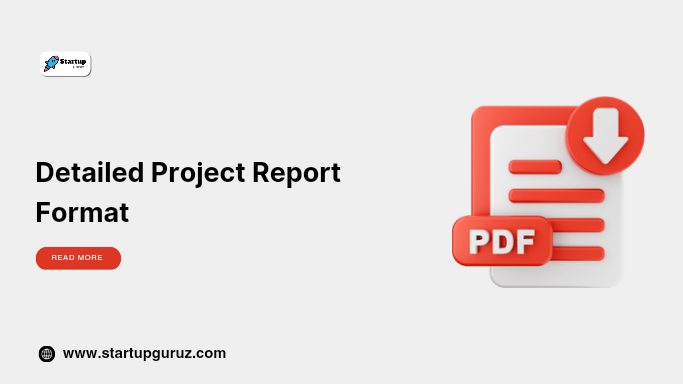Detailed Project Report Format
Detailed Project Report Format: A Complete Guide
A Detailed Project Report (DPR) is a comprehensive document that outlines the specifics of a project, including its objectives, costs, implementation plans, risks, and outcomes. The DPR acts as a roadmap for stakeholders and is often required for business planning, funding approvals, or regulatory compliance. This guide provides insights into creating a detailed project report format, its components, and why it is essential for project success.

What Is a Detailed Project Report (DPR)?
A Detailed Project Report (DPR) is a document that presents an in-depth analysis of a project. It provides information about the project’s feasibility, technical aspects, financial viability, and potential risks. DPRs are critical for obtaining approvals from stakeholders, government bodies, or financial institutions.
Key Purposes of a DPR:
- Resource Allocation: Helps in proper allocation of resources like time, manpower, and money.
- Feasibility Assessment: Evaluates whether the project is viable or not.
- Stakeholder Communication: Provides clarity and transparency to stakeholders.
- Funding Proposals: Essential for obtaining loans or grants.
Essential Components of a Detailed Project Report
1. Executive Summary
The executive summary provides an overview of the project. It includes:
- Project title
- Objectives
- Estimated cost
- Brief implementation strategy
Example:
| Project Title | Development of a Dairy Farm |
|---|---|
| Objective | To establish a sustainable dairy farm with 50 cows |
| Estimated Cost | ₹25,00,000 |
2. Project Objectives
Clearly define what the project aims to achieve.
Example:
- Enhance milk production in rural areas.
- Provide employment opportunities to local communities.
3. Market Analysis
Include a detailed analysis of the market, target audience, and demand for the product or service.
Key Points to Cover:
- Industry trends
- Competitor analysis
- Target market demographics
4. Technical Feasibility
Discuss the technical aspects of the project, such as:
- Required technology and equipment
- Manufacturing process
- Infrastructure needs
5. Financial Plan
Provide detailed financial projections, including:
- Capital investment
- Operational costs
- Revenue projections
- Break-even analysis
Example:
| Expense Type | Estimated Cost (₹) |
|---|---|
| Land Purchase | 10,00,000 |
| Equipment | 5,00,000 |
| Initial Working Capital | 2,00,000 |
6. Implementation Plan
Outline the project timeline and phases of implementation.
Example:
| Phase | Start Date | End Date |
|---|---|---|
| Site Preparation | 01-Feb-2025 | 28-Feb-2025 |
| Equipment Installation | 01-Mar-2025 | 15-Mar-2025 |
7. Risk Analysis
Identify potential risks and mitigation strategies.
Example:
| Risk | Likelihood | Impact | Mitigation Strategy |
|---|---|---|---|
| Delayed Permits | Medium | High | Early submission of applications |
8. Social and Environmental Impact
Assess the project’s impact on the environment and community.
9. Annexures
Include supplementary documents, such as:
- Certificates and licenses
- Technical specifications
- Cost quotations
Steps to Prepare a Detailed Project Report
- Gather Information: Collect all necessary data about the project.
- Define Objectives: Clearly state the project’s purpose and goals.
- Conduct Feasibility Studies: Evaluate technical, financial, and market feasibility.
- Prepare Financial Projections: Create detailed cost and revenue estimates.
- Draft the Report: Organize the information into sections.
- Review and Finalize: Proofread and refine the document before submission.
Benefits of a Well-Structured DPR
- Improved Planning: A detailed plan ensures all aspects are considered.
- Stakeholder Confidence: Builds trust among investors and stakeholders.
- Risk Mitigation: Identifies and addresses potential risks early.
- Regulatory Compliance: Meets the requirements for approvals and permits.
FAQs About Detailed Project Report Format
1. What is a Detailed Project Report (DPR)?
A DPR is a comprehensive document that outlines the technical, financial, and operational aspects of a project.
2. Why is a DPR important?
It is essential for project planning, funding approvals, and regulatory compliance.
3. What are the key components of a DPR?
A DPR includes the executive summary, objectives, market analysis, financial plan, risk analysis, and implementation plan.
4. How do I create a DPR in Excel?
Use Excel for creating tables, financial projections, and charts. Divide the report into sections for better organization.
5. Who prepares the DPR?
DPRs are usually prepared by project managers, consultants, or financial analysts.
6. Is a DPR required for small projects?
While not mandatory, it is beneficial for clarity and planning.
7. Can I use templates for DPR preparation?
Yes, several templates are available online to simplify the process.
8. How detailed should the financial projections be?
Include estimates for capital investment, operational costs, revenue, and profit margins.
9. What is the typical length of a DPR?
A DPR can range from 20 to 100 pages, depending on the project’s complexity.
10. How do I ensure my DPR is professional?
Use a clear structure, concise language, and visual aids like charts and graphs for better presentation.